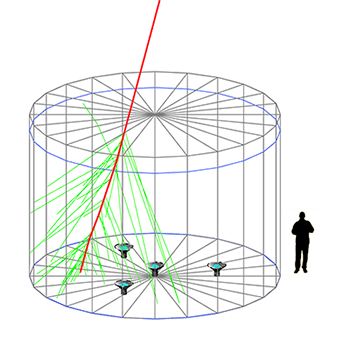 |
| Click image for information. |
The High-Altitude Water Cherenkov (HAWC) Gamma Ray Observatory formally began operations on August 1. This is the culmination of four years of work by a persevering team of scientists and technicians from Mexico and the United States. Researchers from the University of Maryland, including Jordan Goodman, Andrew Smith, Brian Baughman, Jim Braun and Josh Wood, are playing a very prominent role in the construction of HAWC and will help lead in the analysis of data from the observatory.
“HAWC will be the world’s premier wide-field TeV gamma-ray observatory with between 10 and 15 times the sensitivity of previous generation wide-field detectors,” said Goodman, UMD professor and principal investigator for the project.
HAWC is located at an altitude of 4100 meters (13,500’) on the slope of the volcanoes Sierra Negra and Pico de Orizaba at the border between the states of Puebla and Veracruz. The observatory, which is still under construction, uses an array of Cherenkov detectors to observe high-energy cosmic rays and gamma rays. Currently 111 out of 300 Cherenkov detectors are deployed and taking data. Each Cherenkov detector consists of 180,000 liters (40,000 gallons) of extra-pure water stored inside an enormous tank (5 meters high and 7.3 meters in diameter) with four highly sensitive light sensors fixed to the bottom of the tank.
The HAWC array, operating with 111 Cherenkov detectors since August 1 and growing each week, will be sensitive to of high-energy particles and radiation between 100 GeV and 100 TeV, energy equivalent to billion times the energy of visible light.
 |
| Click image for information. |
In 2009, HAWC was identified as the Mexican astronomical project with the highest expected impact on high-energy astrophysics and in the US was endorsed by a joint NSF – DOE panel. Shortly thereafter a test array with three Cherenkov detectors was installed at the volcano Sierra Negra and successfully observed cosmic rays and gamma rays. Following these early tests, a prototype array of seven Cherenkov detectors was built in 2009 to test the tank design, simulate real data-taking, and study the logistics of deploying a large-scale observatory in this remote location. In 2012, the first 30 of 300 HAWC detectors were deployed, and since that time have been operated nearly continuously. The 30-detector stage of HAWC permitted calibration of the observatory via the observation of the shadow of the moon as it blocked cosmic rays.
-----
The Most Energetic Particles in the Known Universe
Gamma rays (electromagnetic radiation of very-high frequency) and cosmic rays (subatomic particles of very-high energy) are products of the most energetic and cataclysmic events in the known universe. These phenomena include the collisions of two neutron stars, the explosions of supernovae, binary systems of stars with stellar accretion, and active galactic nuclei which host black holes millions of times more massive than the Sun.
When high-energy cosmic rays and gamma rays reach the Earth, they interact with air molecules in the upper atmosphere. Gamma rays, for example, are converted into pairs of charged matter and anti-matter particles (mainly electrons and positrons). These particles rapidly interact with other air molecules, producing additional gamma rays of reduced energy which then create further charged particle pairs. This chain reaction proceeds until a large cascade of particles and radiation reaches ground level, where it can be recorded in the HAWC detectors.
When the charged particle cascade from an extra-terrestrial gamma ray passes through a Cherenkov detector, its particles are traveling faster than the speed of light in water. The resulting effect is similar to the shock wave produced in the atmosphere by a supersonic airplane (a "sonic boom"), but instead of producing sound the particles produce a visible cone of blue light. The flash of light, called Cherenkov radiation, is measured by the light sensor fixed to the bottom of each detector in HAWC. By combining the light signal observed in many tanks with fast electronics and high precision computing equipment, it is possible for scientists to determine the time of arrival, energy, and direction of the original extraterrestrial gamma ray or cosmic ray."
For more information see http://www.hawc-observatory.org/